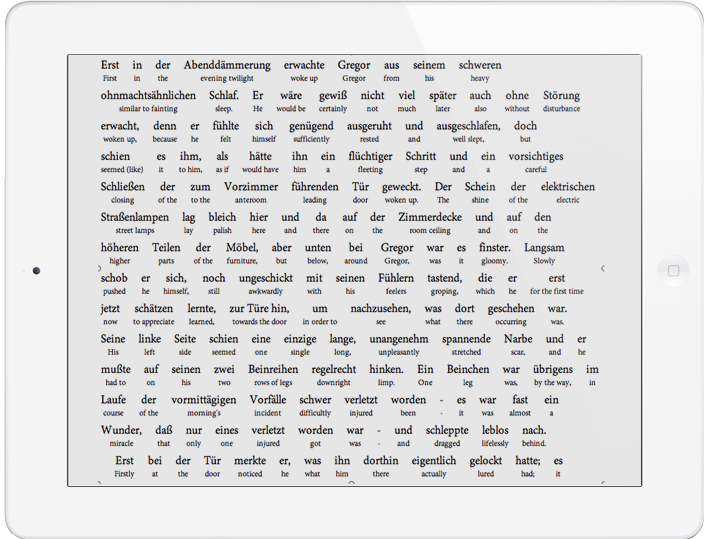This post was originally posted on Babelhut.
Linas Vaštakas is an avid language learning enthusiast, and he currently runs a project InterlinearBooks.com which aims to make literature more accessible to language learners. He wrote this guest post about learning languages with Interlinear texts.
If you have been reading some of the posts about language learning in this blog, you probably know that learning a language requires constant practice . While reading books could be a good source for such practice, doing this is often difficult because the process of translating unknown words is bothersome and often unsuccessful . Today, I would like to talk about my project, which attempts to change this with Interlinear translations . First, however, let me tell you about Interlinear translations.
Example of an Interlinear text from InterlinearBooks.com
What are Interlinear translations?
Interlinear translations are translations of the kind, where the translation is provided below each concrete word and phrase. So, for example, you would have a Swedish translation like this:

Example of Interlinear translation from Swedish
In the Swedish example, you can see how perfectly everything translates. Now, does everything always translate so perfectly in all texts and all languages? Not entirely. But Interlinear translations still aim to preserve the original syntax as long as understanding is possible. If understanding is not possible anymore, a little bit more figurative translation can be used. See this example:

Example of Interlinear translation from Russian
In this example, you can notice that not everything is translatable as directly. Translating that Russian sentence literally, you would get something similar to “To Peter Ivanovich was not destiny to play bridge today evening.” Such translation, although probably still understandable, would quickly become clumsy. So, an Interlinear translation would connect some words to be translated together. It would do so for dogmatic expressions, too. Yet, even in languages like Russian, a lot can be translated literally.
How can Interlinear translations help you?
Interlinear translations can help you learn languages by reading books in your target language without the need of dictionaries, software or teachers. Ever wanted to learn Russian? Why not read some Tolstoy to do that? How about some Selma Lagerlöf, the legendary Nobel prize-winning Swedish writer, for Swedish? Interlinear translations can allow you to read such authors without a dictionary (and we all know how annoying constantly looking up a dictionary can be).
Reading Interlinear books offers a couple of advantages:
- fast reading: Interlinear lets you read fast: you save time by not needing to look up the dictionary, you don’t need to analyze the same sentence in two languages (like you usually need to when reading ordinary bilingual books) and you don’t have explanations inside the text, which would distract you from the original;
- accurate translation: Interlinear translates words precisely and in their context. If you have ever tried using some automatic translation services to help your reading, you must have noticed how, while many translations work alright, some are a little bit off, and it quickly gets annoying. Interlinear translation avoids this problem, because each word is carefully chosen by a human being to have the most accurate meaning for its context;
- selectivity in learning: by being highly literal and corresponding to each word and expression, Interlinear allows you to focus your attention on the important phrases and words you need to learn when reading. Don’t feel like learning terms for nobility in XIXth century Russia? Skip them and just quickly look at the translation! Find that you still can’t remember the word for “create” in Russian? Well, pay more attention – or add it to Anki if you prefer.
Where can you get Interlinear translations?
InterlinearBooks.com has been focusing on translating fascinating books in various languages in the Interlinear format and selling them. We have currently released the following e-book translations:
- German Interlinear translation — bilingual Interlinear translation of a story by Franz Kafka, one of the most well-known German-speaking writers of the XXth century;
- Lithuanian Interlinear book — bilingual translation of certain short stories by Jonas Biliunas, a famous Lithuanian writer of the early XXth century;
- Russian Interlinear book — an Interlinear translation of “The Death of Ivan Ilyich” by Leo Tolstoy, the big classic of Russian literature;
- Swedish Interlinear book —an Interlinear translation of the novel “The Treasure: Sir Arne’s Money” by the Swedish writer Selma Lagerlöf;
- more to come soon… ( subscribe to the InterlinearBooks mailing list to find out what stories we will be translating)
InterlinearBooks is still in the beginning phase of the project and its mission is to bring literature closer to language learners. What translations we make and how we make them can still be largely influenced by our readers, and we are more than willing to hear feedback from you.
Even if not with Interlinear translations, have you ever successfully used reading for language learning? We’d love to hear your story!
